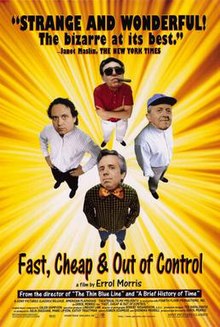Fast, Cheap & Out of Control
| Fast, Cheap & Out of Control | |
|---|---|

Theatrical release poster
|
|
| Directed by | Errol Morris |
| Produced by | Errol Morris |
| Starring |
|
| Music by | Caleb Sampson |
| Cinematography | Robert Richardson |
| Edited by | Shondra Merrill Karen Schmeer |
| Distributed by | Sony Pictures Classics |
|
Release date
|
|
|
Running time
|
80 minutes |
| Country | United States |
| Language | English |
| Box office | $878,960 (USA) |
Fast, Cheap & Out of Control is a 1997 film by documentary filmmaker Errol Morris. It profiles four subjects with extraordinary careers: Dave Hoover, who is a lion tamer; George Mendonça, who created topiaries at Green Animals Topiary Garden in Portsmouth, Rhode Island, including giraffes made out of boxwood; Ray Mendez, a hairless mole-rats expert; and Rodney Brooks, an M.I.T. scientist who has designed bug-like robots.
The film's musical score is by composer Caleb Sampson, and is performed by the Alloy Orchestra. It is characterized as circus-like, sometimes frenzied or haunting, and features percussion (particularly mallets and xylophones) to give it a metallic, technological or futuristic flavor.
In Fast, Cheap & Out of Control, Morris uses a camera technique he invented which allows the interview subject to face the interviewer directly while also looking directly into the camera, seemingly making eye contact with the audience. The invention is called the Interrotron. His four subjects narrate the film in their own words. The cinematographer, Robert Richardson, uses many of the same camera techniques he used in his other films, JFK and Natural Born Killers. In addition to 35 mm cameras, he also uses Super 8 mm film. The film is extensively cut with scenes from older films and television shows.
The film also uses footage from other sources, such as movie clips, documentary footage, and cartoons. Hoover's idol Clyde Beatty appears from portions of his film Darkest Africa and a malicious robot appears in scenes from Zombies of the Stratosphere. After using the first moments in the film to establish his characters one by one, with film clips that correspond to each subject, Morris then begins to mix footage relating to one subject with the narration of another, in order to correlate the themes which the four subjects have in common.
...
Wikipedia
